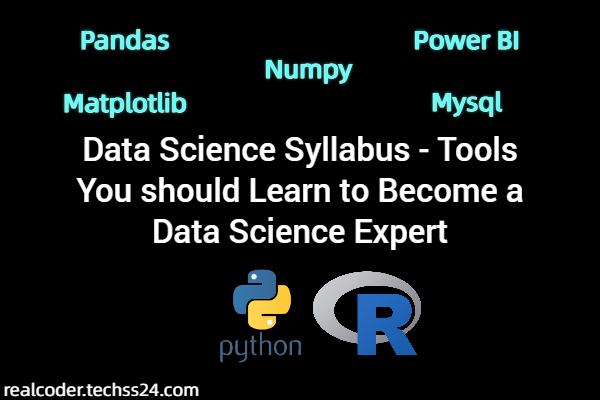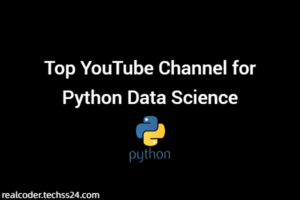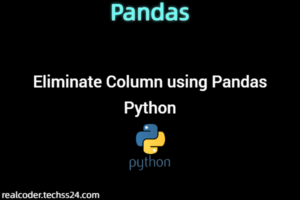The Data Science syllabus is very broad and confusing in terms of what to include and what not to include in the curriculum of the tasks to learn data science skills. So, it is categorized into tools, content, projects, and assignments you should know to learn data science skills.
Tools you should learn to become a data science expert
- Python
- Scikit Learn
- Power BI
- NumPy
- Spark
- Dask
- Pytorch
- Featuretools
- Keras
- Matplotlib
- RASA
- Pandas
- ML Box
- Streamlit
- Flask
- Mysql – SQL etc.
Content to be included in the Data Science syllabus
- Master Microsoft Excel
- Explore Important Formulas and Functions
- Create Charts and Visualizations using MS Excel
- Get Familiar with MySQL
- Creating and updating reports in SQL
- Performing Data Analysis using SQL
- Explore Python for Data Science
- Important libraries and functions in Python
- Reading file and manipulating data in python
- Working with data frames, lists, and dictionary
- Use Matplotlib and Seaborn for data visualization
- Creating charts to visualize data and generate insights
- Univariate and Bivariate analysis using python
- Perform Statistical Analysis on real-world datasets
- Build and Validate Hypothesis using statistical tests
- Generating useful insights from the data
- Importing and working with different kinds of data in Tableau
- Build bubble charts, geo-location charts, and many others
- Learn to create Dashboards in Tableau
- Master storyboarding in Tableau
- Learn to create engaging presentations
- Perform feature engineering in Tableau
- Become familiar with data manipulation in Tableau
- Loading datasets and establishing table relationships in PowerBI
- Work with a different types of charts and dashboards in PowerBI
- Working with Map visualizations and other advanced charts with drill-down functionalities in PowerBI
- Working with power query for data manipulation in PowerBI
- Writing DAX expressions in PowerBI
- Dealing with ambiguous business problems
- Structure a business problem into a data science problem
- Understanding the Machine Learning Lifecycle
- Key Frameworks for each stage in ML Lifecycle
- Present analysis and business insights in an impactful manner
- Communicate ideas and insights to the stakeholders
- Learn Important Machine Learning concepts
- Perform data cleaning and Preprocessing
- In-depth understanding of Basic ML models
- Linear Models, Decision Tree, k-NN
- Math Behind each Machine Learning Algorithm
- Building Classification and Regression Models
- Hyperparameter Tuning to improve model
- Solving real-world business problems using Machine Learning
- Learn the art of Feature engineering
- Feature Generation from time-series data
- Automated Feature Engineering Tool
- Concept of dimensionality reduction
- Feature Selection and Elimination Techniques
- Detailed Understanding of Principal Component Analysis (PCA)
- Concept of Factor Analysis
- Explore the Advanced ML concepts and Algorithms
- Use Ensemble Learning Techniques (Stacking and Blending)
- Understand and Implement Bagging and Boosting Algorithms
- Learn to handle Text data and Image Data
- Working with structured and unstructured data
- Dealing with unsupervised learning problems
- Clustering Algorithms including k-means and Hierarchical clustering
- Important concepts of Deep Learning
- Working of Neural Network from Scratch
- Activation Functions and Optimizers for Deep Learning
- Understand Deep Learning architectures (MLP, CNN, RNN, and more)
- Explore Deep Learning Frameworks like Keras and PyTorch
- Learn to tune the hyperparameters of Neural Networks
- Build Deep Learning models to tackle real-life problems
- Get familiar with the world of Computer Vision
- Transfer Learning for Computer Vision
- Work with popular Deep Learning Framework – Pytorch
- Learn State-of-the-art Algorithms like YOLO, SSD, RCNN, and more
- Work on different types of problems
- Build Face Detection and Pose Detection Models
- Advanced CV Problems like Image Segmentation and Image Generation
- Understand how GANs work
- Handling Text Data (Cleaning and Pre-processing)
- Use Spacy, Rasa, and Regex for exploring and processing text data
- Information Extraction and Retrieval from text-based data
- Understand Language Modelling
- Learn Advanced Feature Engineering techniques
- Build NLP models for Text Classification
- Understand Topic modeling
- Work on Industry Relevant Projects
- Understand the concept of Sequence-to-Sequence Modeling
- Build a Deep Learning Model for Language translation in PyTorch
- Learn to use the Transformers library by Huggingface
- Use Transformers to perform transfer learning in NLP
- Build and Deploy your own chatbot
- Learn to work with audio-based data
- Build a voice assistant system using Deep Learning
- Recommender Systems in the industry
- Detailed Taxonomy of types of Recommender Systems
- Collaborative Filtering Methods
- Content-Based Recommender Systems
- Knowledge-Based & Hybrid Recommender Systems
- Market Basket Analysis & Association Rules
- Evaluation of Recommender Systems
- Build Book recommender System and other real-life projects
- Important concepts of Time Series Forecasting
- Machine Learning techniques for Time Series forecasting
- Validation techniques for Time series data
- Framework to evaluate Time Series Models
- Exponential Smoothing Methods for forecasting
- Reading ACF and PACF plots
- Tuning Parameters for ARIMA
- ARIMA and SARIMA Model
- Deep Learning for time series
- Solve Real-world business problems
- Understanding the different roles in Data Science
- Dos and Don’ts for Resume Building
- Tips and strategies to build the perfect resume
- Preparing for Data Science Interviews
- Understanding the important skills required
- How to build your digital Presence
- Tips and Tricks to Ace Data Science Resume
- List of Interview Questions for Data Science
- Overview of Python Basics
- Documentation and Formatting
- Testing and Debugging
- Exception Handling and Assertions
- Python Standard Libraries
- Functional Programming
- Object-Oriented Programming
- Working with Shell/Terminal Commands
- Introduction to Version Control and Github
- Connecting with DataBases
- Introduction to Hadoop and Spark Ecosystem
- Deep Dive into Spark Ecosystem
- RDDs in Spark
- DataFrames in Spark
- Spark SQL
- Data Wrangling with Spark
- Jobs, Stages, and Tasks in Spark
- Advanced Programming in Spark
- Machine Learning with Spark ML
- Overview and aspects of Model Deployment
- Deploying Machine Learning models using Streamlit
- Introduction to Amazon Web services
- Deploying and Machine Learning Deep Learning models using AWS
- Understanding Amazon Sagemaker
- Model Deployment using Sagemaker
- APIs for Model deployment
Projects in the Data Science Syllabus
There can be any number of projects in the Data Science Syllabus, but it has to be more than 30+ projects in order to learn the data science skills like an expert. These projects are to be industry-specific only. Here is the list of some projects –
Auto Correct
Face Detection
Web Traffic Prediction
Movie Recommender System
Malaria Detection from blood cell Images
Webpage Classification
Customer Churn Prediction
NYC Taxi Trip Duration Prediction
Handwritten Digit Recognition
Gender and Age Detection master
Projects list can increase to any number.
These are the major things which are to be covered in data science syllabus to increase its ranking.
Best YouTube Channel for Data Science
Python Pandas
Python Matplotlib
Python Basic to Advance
Happy Learning – If you require any further information, feel free to contact me.



![[Solved] Customer Details using Pandas Python](https://realcoder.techss24.com/wp-content/uploads/2022/06/Solved-Customer-Details-using-Pandas-Python-300x200.png)